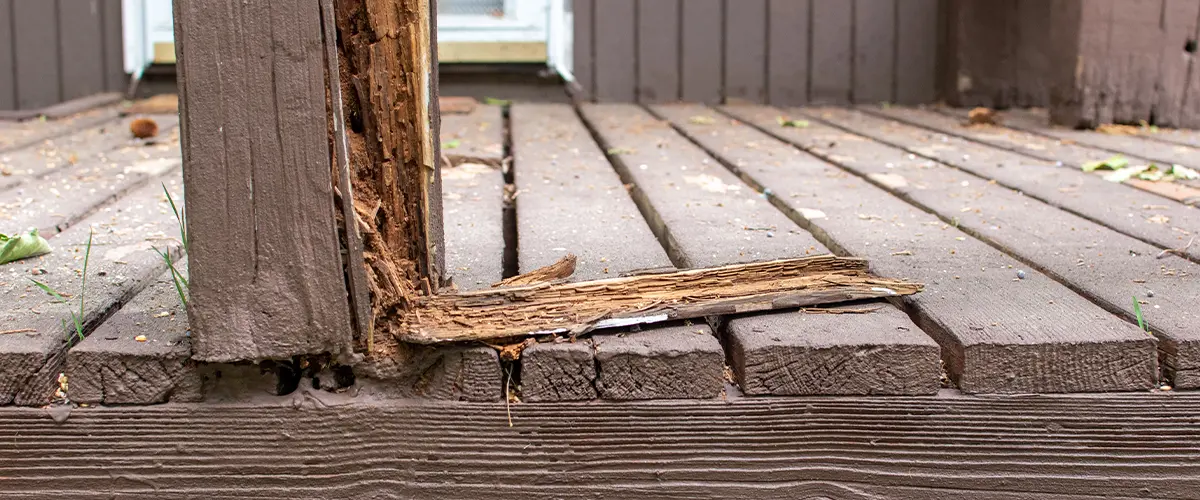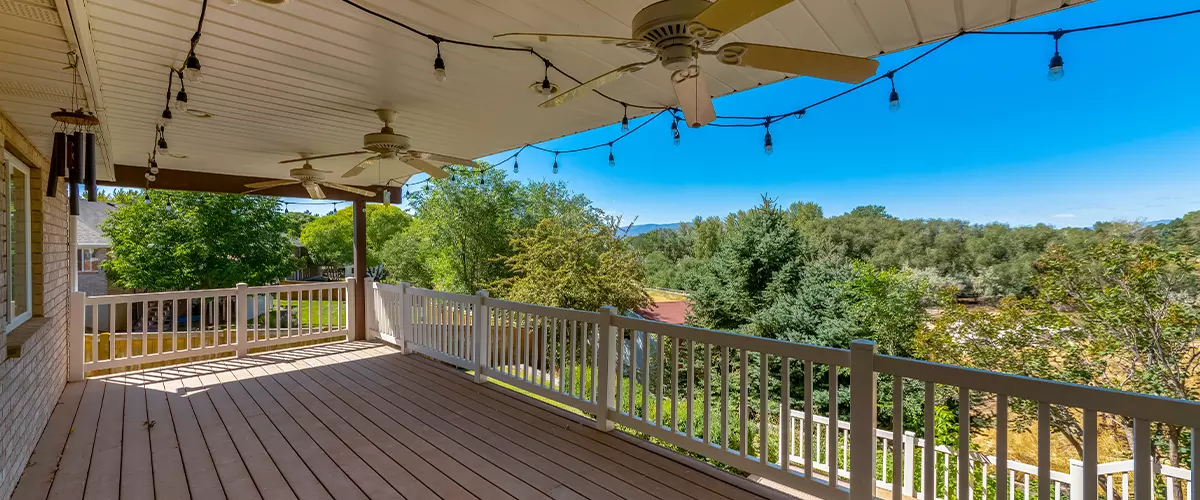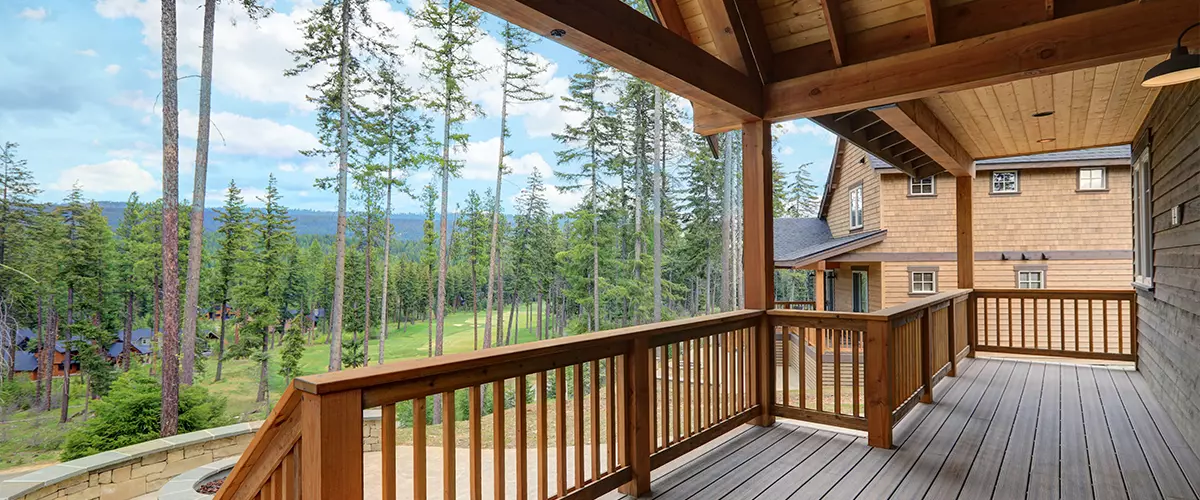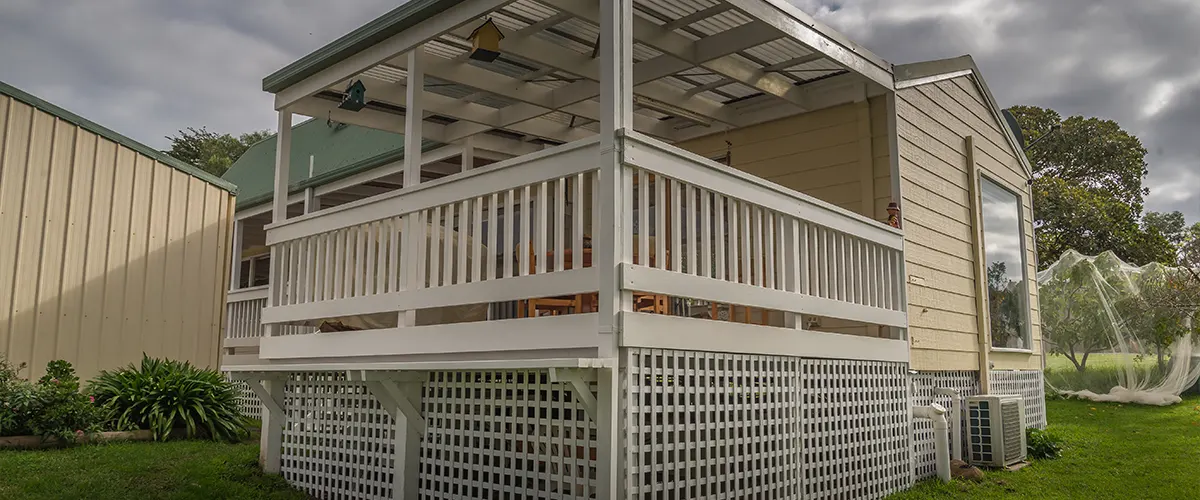Experiencing issues with your deck can be both frustrating and risky.
In the U.S., about 6,500 people a year are injured due to deck collapses or rail failures alone.
This article provides an in-depth look at the top 10 decking safety issues you need to be aware of, helping you ensure your outdoor space is secure and inviting for everyone.
Ready to make your deck safer?

Key Takeaways
- Stairs with open risers or missing railings can pose trip hazards and increase the risk of falls and injuries.
- Improper railing height and baluster spacing can compromise the security of your deck, especially for children and pets.
- Undersized structural members, such as beams and joists, can lead to instability, collapse, and accidents.
- Missing or improper joist hangers compromise the structural integrity of your deck.
Top 10 Deck Safety Issues You Need To Watch For

The Importance of Knowing The Under Deck Ceiling Pros And Cons
Stairs with open risers or missing railings
Open risers – the visible gap between each step – can pose trip hazards, especially for children and the elderly who might not lift their feet high enough while climbing up.
Likewise, missing railings don’t provide support for those ascending or descending the stairs, increasing the risk of falls and injuries. Such issues also violate most local building codes that mandate secure handrails and closed rises on outdoor decks to ensure user safety.
Improper railing height and baluster spacing
Ignoring proper railing height and baluster spacing could lead to severe deck safety issues. A railing that’s too low compromises the security of your outdoor space, especially for children and pets.
Your local building code sets minimum heights for railings to ensure they serve their purpose; keeping people safe on elevated surfaces.
On the other hand, incorrect baluster spacing might allow small children to squeeze through or become trapped between them – a major concern for parents who want their kids to safely enjoy the deck area.
Undersized structural members
Undersized structural members pose severe risks. These include the beams and joists that support your deck boards – these components should have precise dimensions to provide adequate stability.
An undersized beam or joist may lead to unanticipated collapse due to insufficient load-bearing capabilities, even under normal use. Therefore, choosing durable deck materials and ensuring proper installation of deck boards forms a crucial part of effective outdoor deck safety measures.
Regular inspection for any signs of decay in these structures can help prevent potential accidents on your beloved outdoor resting space.
Missing or improper joist hangers
One of the key deck safety issues to watch out for is missing or improper joist hangers. These small but crucial metal connectors are responsible for attaching the deck’s horizontal support beams (joists) to its vertical supporting posts.
When joist hangers are missing or installed incorrectly, it can compromise the structural integrity of your deck, leading to sagging and potential collapse.
Improper deck materials
Using improper deck materials can lead to significant safety issues. It’s essential to choose durable and weather-resistant materials that will withstand the elements and provide a sturdy foundation for your deck.
This includes using pressure-treated lumber or composite decking boards that are resistant to rot, decay, and insect damage. By investing in high-quality deck materials, you’ll not only enhance the safety of your deck but also increase its longevity and overall appeal.
Undersized footings
Undersized footings are a common deck safety concern that can lead to significant structural deck issues. Footings provide the essential support for your deck, distributing the weight and preventing it from sinking into the ground.
When footings are undersized, they may not be able to bear the full load of the deck, causing it to shift or even collapse.
By ensuring that your footings are appropriately sized, you can prevent serious safety hazards and protect yourself and your loved ones from potential accidents or injuries on your deck.
Improper attachment to the structure or house (incorrect fasteners)
One of the most critical deck safety issues to watch for is improper attachment to the structure or house, often caused by using incorrect fasteners. When decks are not properly attached, there is a risk of collapse or structural damage, posing a serious hazard to people using the deck.
To ensure proper attachment, it’s essential to use the right type and size of fasteners recommended by building codes and manufacturers. This includes choosing corrosion-resistant screws or bolts specifically designed for outdoor use.
Improper or missing flashing
Improper or missing flashing is a serious deck safety issue that can lead to water damage and rotting of the deck structure. Flashing is a thin, metal material that is installed around certain areas of the deck, such as where it meets the house or where two different materials join together.
Its purpose is to prevent water from seeping into these vulnerable areas and causing damage.
Without proper flashing, water can seep into the gaps between the deck and the house, leading to moisture buildup and potential structural issues. Over time, this can weaken the integrity of your deck, making it unsafe for use.
Not obtaining a permit to build a deck
Building a deck without obtaining the necessary permit is a serious safety concern. Permits are required to ensure that the deck meets local building codes and regulations, guaranteeing its stability and durability.
Without a permit, you run the risk of constructing an unsafe deck that could potentially collapse or cause injury to yourself or others. It’s essential to abide by the rules and obtain the proper permits before starting any deck construction project to ensure the safety of everyone who will be using it.

Deck Safety Checklist
- Replace rotten wood
- Replace Fasteners
- Pay attention to cracks and creaks
- Repair loose railings
- Check For Bug Damage
- Inspect Under The Deck
- Maintain Regular Deck Inspections
Regular deck inspections are crucial for maintaining the safety of your outdoor space. By conducting routine checks, you can identify potential hazards before they become major issues.
Look out for any signs of damage, such as rotten wood, loose railings, or cracks in the deck surface. It’s also essential to inspect underneath your deck for mold or mildew growth and to ensure that critters haven’t made their home there.
By staying vigilant and performing regular maintenance tasks like these, you’ll be able to enjoy your deck with peace of mind knowing it’s a safe and secure space for everyone to enjoy.
Conclusion
In conclusion, ensuring deck safety is of utmost importance to prevent accidents and injuries. By being aware of the top 10 deck safety issues, such as open risers, improper railing height, and undersized structural members, you can take proactive measures to address these concerns promptly.
Regular inspections and maintenance should be a priority to keep your deck safe for everyone’s enjoyment. Remember to follow code compliance guidelines and seek professional help when needed.
Stay vigilant and enjoy your outdoor space with peace of mind knowing that your deck is secure.

FAQs
Talk To Knoxville's Deck Pros
Trust in Riverview Decks to deliver high-quality under deck ceiling solutions that meet your needs and exceed your expectations. Call us at (865) 801-4545 and let’s talk deck building!
